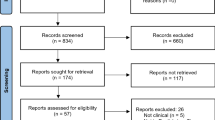Abstract
Objectives
To compare outcomes in pain relief and motor functional recovery in patients with an osteoid osteoma treated by magnetic resonance guided focused ultrasound surgery (MRgFUS) or radiofrequency ablation (RFA) using a propensity score matching study design.
Methods
Thirty patients with osteoid osteomas were included in this institutional review board (IRB)-approved study. MRgFUS was performed in 15 subjects. These subjects were matched by propensity analysis with a group of 15 subjects treated by RFA. Pain relief in terms of complete response (CR) and motor functional recovery were measured.
Results
A similar proportion of subjects treated by MRgFUS (94 %) or RFA (100 %) experienced CR 12 weeks after treatment, with no significant difference. The improvement in pain control following MRgFUS or RFA paralleled with improved motor functional recovery. The treatment failure rate was 6.6 % in the MRgFUS group and 0 % in the RFA group. No major complications were observed following either ablative treatment.
Conclusions
Although this study involved a limited number of patients, MRgFUS favourably improves perceived pain and motor functional recovery, with no major complications. No difference was found in the achievement of primary and secondary outcome measures with respect to RFA.
Key Points
• To demonstrate the effectiveness of a recent technique for treating osteoid osteoma
• MRgFUS results compared with results of the gold standard treatment (RFA)
• MRgFUS is effective both from a clinical and functional point of view
• No significant side effects compared with RFA










Similar content being viewed by others
References
Staso M, Zugaro L, Gravina GL et al (2011) A feasibility study of percutaneous radiofrequency ablation followed by radiotherapy in the management of painful osteolytic bone metastases. Eur Radiol 21:2004–2010
De Filippo M, Bozzetti F, Martora L et al (2014) Radiofrequency thermal ablation of renal tumors. Radiol Med 119:499–511
Floridi C, Radaelli A, Abi-Jaoudeh N et al (2014) C-arm cone-beam computed tomography in interventional oncology: technical aspects and clinical applications. Radiol Med 119:521–532
Splendiani A, Perri M, Conchiglia A et al (2013) MR assessment of lumbar disk herniation treated with oxygen-ozone diskolysis: the role of DWI and related ADC versus intervertebral disk volumetric analysis for detecting treatment response. Int J Ozone Ther 12:25–33
Motamedi D, Learch TJ, Ishimitsu DN et al (2009) Thermal ablation of osteoid osteoma: overview and step by-step guide. Radiographics 29:2127–2141
Rosenthal DI, Alexander A, Rosenberg AE et al (1992) Ablation of osteoid osteomas with a percutaneously placed electrode: a new procedure. Radiology 183:29–33
Napoli A, Anzidei M, Ciolina F et al (2013) MR-guided high-intensity focused ultrasound: current status of an emerging technology. Cardiovasc Intervent Radiol 36:1190–1203
Schlesinger D, Benedict S, Diederich C et al (2013) MR-guided focused ultrasound surgery, present and future. Med Phys 40:080901
Masciocchi C, Conchiglia A, Gregori LM et al (2014) Critical role of HIFU in musculoskeletal interventions. Radiol Med 119:470–475
Napoli A, Mastantuono M, Cavallo Maricola B et al (2013) Osteoid osteoma: MR-guided focused ultrasound for entirely noninvasive treatment. Radiology 267:514–521
Stratford PW, Binkley JM, Stratford DM (2001) Development and initial validation of the upper extremity functional index. Physiother Can 53:259–267
Binkley JM, Stratford PW, Lott SA et al (1999) The lower extremity functional scale (LEFS): scale development, measurement properties and clinical application. Phys Ther 79:371–383
Conover WJ (1999) Practical nonparametric statistics, 3rd edition. John Wiley & Sons, New York
Chai JW, Hong SH, Choi JY et al (2010) Radiologic diagnosis of osteoid osteoma: from simple to challenging findings. Radiographics 30:737–749
Edeiken J, DePalma AF, Hodes PJ (1996) Osteoid osteoma. (Roentgenographic emphasis). Clin Orthop Relat Res 49:201–206
Davies AM, Sundaram M, James SJ (eds) (2009) Imaging of bone tumors and tumor-like lesions: techniques and applications. Springer, Berlin Heidelberg
Daniilidis K, Martinelli N, Gosheger G et al (2012) Percutaneous CT-guided radio-frequency ablation of osteoid osteoma of the foot and ankle. Arch Orthop Trauma Surg 132:1707–1710
Xie C, Jeys L, James SL (2015) Radiofrequency ablation of chondroblastoma: long-term clinical and imaging outcomes. Eur Radiol 25:1127–1134
Rosenthal DI, Hornicek FJ, Torriani M et al (2003) Osteoid osteoma: percutaneous treatment with radiofrequency energy. Radiology 229:171–175
Rehnitz C, Sprengel SD, Lehner B et al (2012) CT-guided radiofrequency ablation of osteoid osteoma and osteoblastoma: clinical success and long-term follow up in 77 patients. Eur J Radiol 81:3426–3434
European Commission (2000) European guidelines for quality criteria for computed tomography. Chapter 1, Appendix I. EUR 16262 EN. European Commission, Luxembourg
Acknowledgements
The scientific guarantor of this publication is Prof. Carlo Masciocchi. The authors of this manuscript declare no relationships with any companies whose products or services may be related to the subject matter of the article. The authors state that this work has not received any funding. One of the authors has significant statistical expertise. Institutional review board approval was obtained.
Written informed consent was obtained from all patients in this study. Methodology: retrospective, observational, performed at one institution.
Author information
Authors and Affiliations
Corresponding author
Rights and permissions
About this article
Cite this article
Masciocchi, C., Zugaro, L., Arrigoni, F. et al. Radiofrequency ablation versus magnetic resonance guided focused ultrasound surgery for minimally invasive treatment of osteoid osteoma: a propensity score matching study. Eur Radiol 26, 2472–2481 (2016). https://doi.org/10.1007/s00330-015-4111-7
Received:
Revised:
Accepted:
Published:
Issue Date:
DOI: https://doi.org/10.1007/s00330-015-4111-7




